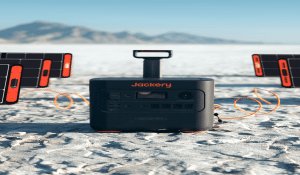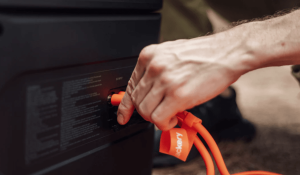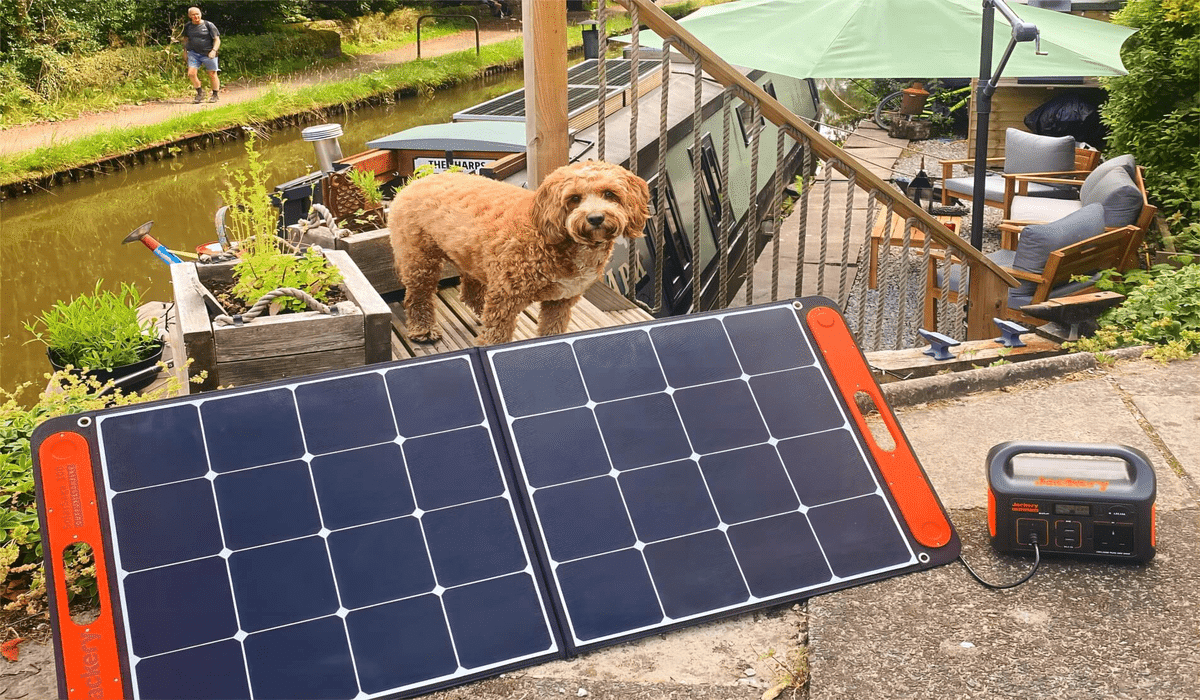Table of Contents
The generator explicitly designed to meet the power requirements of maritime settings is referred to as the Marine Generator. It comprises an internal combustion engine that generates mechanical energy. A generator head is coupled with the internal combustion engine, which converts the generated mechanical energy into electrical energy.
From lighting, air conditioning, and refrigeration to navigation systems and communication devices, a marine generator serves as a reliable power source for vital equipment on board. So, a marine generator offers the advantage of self-sufficiency by ensuring independence from unreliable shore power sources.
A typical marine generator utilizes traditional fossil fuels to generate energy. However, that is not the case with marine solar generators. They rely on a renewable energy source, i.e., solar panels, to produce power. Marine solar generators harness the power of the sun to provide a sustainable energy alternative. Cherry on top, in the US, solar energy has the highest potential for electricity production among renewable energy sources.
In this write-up, we’ll discuss various aspects of maritime generators, including their types and tips for choosing the most desirable option.
Types of Marine Solar Generators
Coming to the subcategories of marine solar generators, there are two main options onboard, portable and fixed solar generators. Both options have some key features and distinct advantages, as discussed below:
Portable Marine Generators
Portable marine solar generators, as the name suggests, can be moved around to capture maximum sunlight in the best possible position. Consider them standalone units with a marine battery storage system and solar panels. In addition to that, they have integrated inverters that generate electrical energy from solar energy.
Resourcefulness, versatility, and ease of installation are some of the notable strengths associated with marine portable solar generators. One can reposition them throughout the day to gain optimal sun exposure.
They can be detached to provide energy for activities like camping or as an emergency power backup on land. Lastly, their installation is simple and doesn’t require a durable transformation in the boat itself.
Compatibility for Different Boats and Yachts
The lightweight and easily transportable compact design of portable solar generators makes them perfect for small boats and yachts. They can be easily stationed on the deck or cockpit for adequate sun exposure.
When it comes to sailboats and catamarans, portable marine generators offer great flexibility. From deck and railing to bimini tops and arches, their compact design manages to fit every space.
Fixed Marine Generators
On the other hand, fixed marine generators require permanent integration into the structure of a boat or yacht. Their energy production interface is the same as the portable ones. However, fixed solar generators typically have large surface areas, which allows them to deliver increased energy output.
Seamless integration, significant energy output, and long-term investment are some of the major perks associated with fixed marine solar generators.
Their large surface area allows significant energy production to fulfill the power requirements of large boats or yachts. Lastly, buying fixed marine solar generators means a long-term investment in renewable energy. Fuel costs and harmful environmental impact of traditional generators are reduced, and a clean energy source is ensured for years to come.
Compatibility for different Boats and Yachts
Large yachts and sailboats have high energy demands, which the marine battery of fixed solar generators can easily fulfill. On top of that, they have adequate deck space available for permanent integration of the fixed generator.
Long-distance cruising and liveaboards mean a long-term reliable energy source is needed to meet the power requirements of equipment onboard. In such circumstances, the traditional boat battery might not be adequate enough to fulfill power requirements.
The Comprehensive Guide to Selection of a Marine Solar Generator
Solar energy accounts for 39% of the new energy-generating capacity addition to the US[2] electrical grid in the first half of 2022. Metrics are now shifting towards green and clean energy sources. High fuel costs, finite fossil fuel reserves, and harmful environmental impact are the main reasons behind this revolution.
While people are shifting towards renewable energy resources, it’s critical to make the investment worthwhile by considering requirements, expectations, pros, and cons. The same goes for marine solar generators.

Power Requirements
One must calculate the power requirements by adding the individual energy demand of equipment onboard.
While making calculations, one must not forget to consider any surges in power demands. Marine solar generators come with battery capacities ranging from a few dozen amp-hours (Ah) to several hundred Ah. The higher the calculated value, the higher shall be the battery capacity of the opted marine solar generator.
Equipment Compatibility
The marine solar generators shall be compatible with the onboard equipment. The compatibility can be ensured by aligning appliances’ voltage and frequency requirements with the generator’s output.
Otherwise, the generator will fail to work in compliance with the equipment of the boat or yacht.
Quality and Capacity of Solar Panels
The solar panels that come with the marine generator must provide good conversion efficiency and durability. High-quality solar panels yield optimal performance and can withstand marine conditions.
When it comes to capacity, higher-wattage panels will generate more electrical energy and vice versa. However, higher-wattage panels will occupy more space, meaning the boat shall be spacious enough to entertain the massive panels.
Environmental Stability
The durability of marine generators must be ensured as they have to withstand harsh marine conditions. They must be resilient toward water, salt, and vibratory forces.
The easiest way to ensure environmental stability is by verifying that the generator has the required certifications for marine use. The materials that enhance a generator’s longevity include marine-grade stainless steel, corrosion-resistant coatings, and robust, water-resistant enclosures.
Budget
High-quality marine solar generators might seem an expensive investment, but they are extremely cost-effective in the long run. Their performance, durability, and little maintenance make every single penny worth it.
In the last two years, solar prices[3] sharply rose in the USA but are still a much cheaper option than non-renewable sources. So, in the long-term, one saves money because of independence from expensive fuels and frequent maintenance of traditional generators.
Reviews and Recommendations
Considering customer reviews and ratings is a great way to judge the reliability of a marine solar generator. By shortlisting the top companies based on positive reviews, one can easily opt for the most optimal marine solar generator that fits personal requirements and expectations as well.
Picking the Best One
Consideration of important features, requirements, and expectations along with the research process might seem like a tiresome task. If one wants to skip such steps, then the most desirable way to make the right choice is by going for a well-known and reliable company like Jackery.
The Jackery Solar Generator 1000 is an optimal choice and a wise investment. It offers 1000W running wattage and 2000W surge wattage with convenient and fast recharging methods. Its portability and compactness make it an excellent fit for maritime settings. Lastly, it claims zero emissions and minimal noise while operating, which means one is making an investment that is contributing to a greener future.

Frequently Asked Questions
What is the cost of a marine solar generator?
The cost varies depending on factors like brand, features, battery capacity, and power output. Generally, the price ranges from a few hundred dollars for small-capacity portable generators to several thousand dollars for high-capacity fixed marine solar generators.
What is the cooling process of a marine generator’s engine?
Marine generators achieve cooling via water-based cooling systems. Such systems utilize seawater or freshwater to optimize the temperature of the generator’s engine.
Heat Exchanger pumps water, which draws heat away from the engine. Ultimately, the generator’s engine cools down.
For how long does a marine generator last?
Typically, marine generators last between 5000 to 10,000 hours of operation. However, this time span can vary following the quality, maintenance, and usage of the generator.
Regular and proper maintenance aids in increasing the lifespan of marine generators. The same goes for the quality factor. If one has invested in a premium quality solar generator, it’ll last longer and vice versa.
Are AC and DC marine solar generators different from each other?
AC refers to Alternating Current, while DC refers to Direct Current. AC generators produce power in the form of alternating current, while DC generators produce direct current.
The electrical output of AC generators makes them suitable for powering standard AC appliances.
What are the important factors of consideration when it comes to marine solar generators?
Solar panel capacity, battery capacity, power output, durability, and cost are important factors to consider when buying a marine solar generator.
Additionally, one must verify the reputation of the manufacturer and its suitability for marine environmental conditions. The easiest way to opt for a reliable brand is by researching the customer reviews of different brands and comparing them with each other.
Elevate your Marine Experience with Sustainable Power

Reliable power sources are critical to ensure the efficient operation of marine activities. That’s where marine solar generators step in with added benefits of cost reduction and positive environmental impact.
Cost-effective
Last year, the USA faced a 19.4 percent surge in imported fuel prices. So, relying on traditional generators means breaking the bank by paying hefty fuel and maintenance charges. In contrast, marine solar generators are a cost-effective alternative as they harness the energy of the sun to produce electricity. Initially, the investment might seem heavy, but in the long term, one ends up saving money because of little maintenance cost and independence from finite fossil fuel reserves.
Environmental Effect
Moreover, the minimal environmental footprint of marine solar generators cannot be neglected. By utilizing solar power, one can play a significant role in minimizing the harmful impact of carbon emissions on the fragile ecosystem. Investing in a solar generator means investing in a cleaner and greener future.
Disturbance-free
Another benefit of solar generators is their silent operation. Unlike traditional generators, they don’t produce disruptive noises while operating.
Flexibility and Versatility
The versatility and flexibility that marine generators offer are exceptional. They are easy to navigate, and boat owners can quickly expand the system to accommodate increasing energy demands.
So, for people who are seeking an efficient and sustainable marine power source, investing in a solar generator is the most optimal choice.
Conclusion
To bring it all together, marine solar generators are a revolution towards a healthy, clean, and green environment. They are eco-friendly, cost-effective, versatile, durable, flexible, and whatnot.
When it comes to the most reliable company for buying marine generators, Jackery is one of a kind. Apart from offering a wide range of solar generators with varying battery capacities, they never fail to bring exciting offers onboard, like a free warranty extension and a 30-day money-back guarantee.
To accommodate their customers, they have arranged budget-friendly financial plans as well, with installments starting from as low as 55$ per month. They are transparent in their policies and have a customer-centric approach.
Additionally, they offer free delivery and accessible customer service to ensure that their customers get value for every cent. Lastly, the customer feedback on their website speaks for the reliability and premium quality of their marine solar generators.


